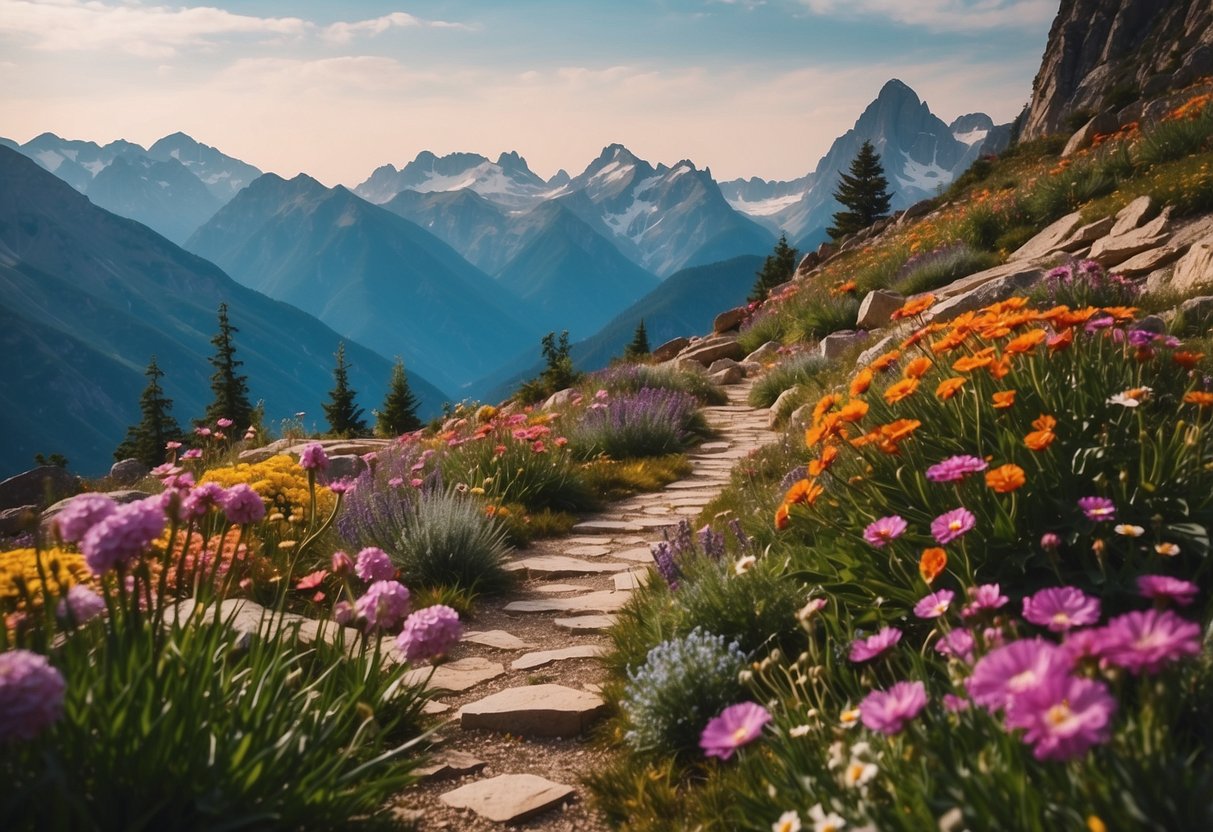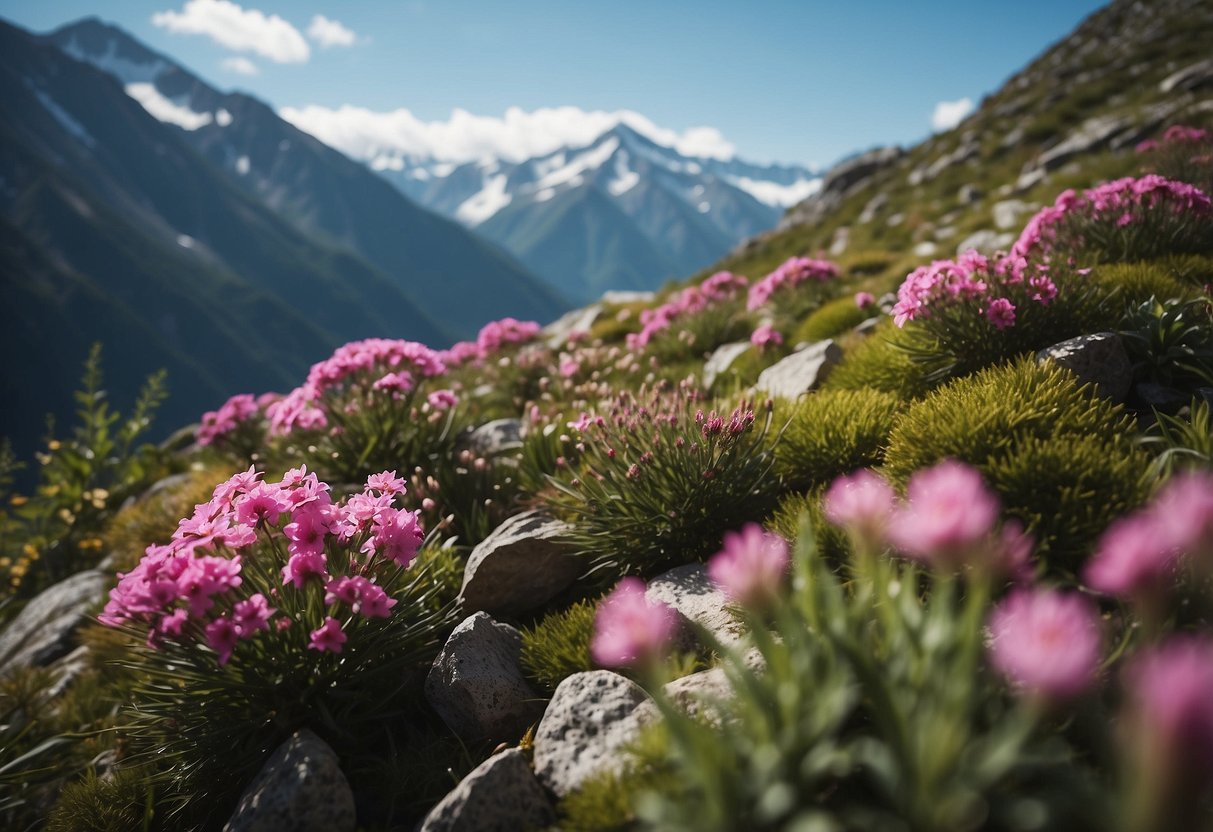Alpine Garden Ideas: Create Your Perfect Mountain Oasis
Creating an alpine garden can be a rewarding project that brings a touch of the mountains to your backyard. These gardens simulate the conditions of high altitudes, where the plants naturally thrive. This makes them ideal for rugged terrains and hard-to-landscape areas.

Why consider an alpine garden for your home? These gardens are not only visually appealing but also relatively low-maintenance once established. By incorporating rocks, gravel, and drought-tolerant plants, you can create a beautiful, sustainable garden space. Explore different ideas and methods to make your alpine garden truly unique.
1) Rock Cress

Rock Cress is a great choice for your alpine garden. It creates a lush, colorful carpet that looks stunning around stepping stones or pathways.
This plant thrives in well-drained soil and loves the sun. You’ll see beautiful blooms in spring, which attract butterflies. You can combine it with other alpine plants for a natural, low-maintenance garden.
Rock Cress is an evergreen perennial, so it stays green all year. It’s perfect for edging garden beds and adding vibrant color to your landscape.
2) Saxifraga

Saxifraga, also known as saxifrage, is a wonderful addition to your alpine garden.
This hardy perennial thrives in rock gardens and provides year-round interest with its robust foliage and star-shaped flowers.
It’s a low maintenance plant. Saxifraga grows well in moist, well-draining soil and can handle both sun and partial shade. For a splash of color, consider Saxifraga oppositifolia, which produces bright magenta or purple flowers in spring. This tiny, mat-forming plant adds a vibrant touch with its dense carpet of dark green leaves.
3) Creeping Thyme

Creeping thyme, also known as Thymus serpyllum, is a low-growing ground cover. It has tiny, aromatic leaves that look great and smell amazing.
You can grow creeping thyme in sunny spots with good drainage. It’s perfect for filling gaps between stepping stones or cascading over rocks.
This plant can thrive in nutrient-poor soil, making it easy to care for. Plus, it adds a pop of green to your alpine garden. For more details, check out this guide to creeping thyme.
4) Alpine Pink

Alpine Pink, or Dianthus alpinus, are perfect for mountain gardens.
They have compact growth and vibrant, fragrant flowers. These hardy perennials can survive cold, drought, heat, and even salt.
Alpine Pink adds a burst of color to any rock garden. Plant them where they can get plenty of sun and well-drained soil.
For more tips on these colorful plants, check out Alpine Pink: Vibrant Blooms for Mountain Gardens.
5) Edelweiss

Edelweiss is an iconic alpine flower that adds charm to any garden. It has star-shaped, woolly white blooms that grow in late spring to early summer. The flowers stand out against the plant’s narrow, silvery green leaves.
These flowers thrive in well-draining soil, making them perfect for rock gardens. Aim for a soil pH between 6.5 and 7.5.
You can plant Edelweiss from seeds. It’s also known for its ability to self-seed under the right conditions, slowly spreading over time. For more details on care, check out how to grow Edelweiss.
6) Dwarf Iris

Dwarf Iris is a perfect choice for your alpine garden. These small yet vibrant flowers thrive in well-drained soil and prefer a sunny spot.
There are many varieties, including the Miniature Dwarf Bearded Iris ‘Alpine Lake’. These irises are easy to care for and add a splash of color.
You can also consider the Iris Reticulata. This type does well even in partial shade and comes in various colors.
7) Evergreen Candytuft

Evergreen Candytuft, or Iberis sempervirens, is a fantastic addition to your alpine garden. This plant is known for its clusters of delicate white blossoms that appear from mid to late spring.
Once established, it’s drought-tolerant and can thrive in poor soils, making it a low-maintenance choice. It is great for borders, paths, or walkways and looks amazing cascading over the edge of raised beds.
Evergreen Candytuft attracts beneficial insects like hoverflies, enhancing the biodiversity of your garden. It grows well in rock gardens and can be used as ground cover in small areas. For more information, visit Gardenia.
8) Rockfoil

Rockfoil (Saxifraga) is a fantastic choice for your alpine garden. These plants form low-growing mounds or creep across the ground, producing tiny, charming flowers.
Rockfoil thrives in cool, shaded areas and can grow in USDA plant hardiness zones 5 to 7. This makes it perfect for temperate regions.
You can easily incorporate rockfoil into your garden or even use it to fill gaps in dry stone walls. Its adaptability and unique look make it a must-have for any alpine garden.
9) Moss Campion

Moss Campion is a charming plant for your alpine garden. It creates a low, evergreen carpet that’s only about an inch high. This makes it perfect for rock gardens or pathways.
The plant prefers gritty, well-draining soil and full sun. It’s also great between pavers since it can handle light foot traffic. Moss Campion will bring a touch of alpine beauty to your garden with its pink or purple flowers in the spring. You can find more details on growing conditions here.
10) Dwarf Rhododendron

Dwarf Rhododendrons are perfect for adding vibrant colors to your alpine garden. These compact plants fit well in small spaces, usually reaching no more than 1 meter in height.
They come in beautiful shades like white and pink. The evergreen foliage adds year-round interest. Some varieties, like ‘Ginny Gee,’ boast striking flowers with pink-edged petals.
Dwarf Rhododendrons thrive in well-drained, slightly acidic soil. They add a stunning focal point to any garden while being relatively easy to care for. For more detail on specific varieties, check out these dwarf Rhododendron varieties.
Understanding Alpine Gardens

In order to start an alpine garden, you need to focus on the unique climate and soil conditions that these plants prefer. Location is also key to creating a thriving alpine garden.
Climate and Soil Requirements
Alpine gardens thrive in cool climates with well-drained soil. They are adapted to extreme conditions, such as harsh winds, intense sunlight, and cold temperatures. These plants often come from mountainous regions where the soil is rocky and poor in nutrients.
You should aim to mimic these conditions in your garden. Use gritty or sandy soil and avoid heavy, clay soils that retain too much water. Adding gravel or small rocks to your soil mix can help improve drainage.
Remember that most alpine plants prefer full sun, so choose a sunny spot in your garden. In hotter climates, some shade may be needed during the hottest part of the day to prevent the plants from overheating.
Ideal Locations for Alpine Gardens
When choosing a location for your alpine garden, look for areas that naturally have good drainage. Slopes and raised beds are ideal since they prevent water from pooling around the plant roots.
Rock gardens are another great option as they can provide the drainage and rocky conditions that alpine plants love. You can even create a small rockery in a corner of your existing garden.
If you have limited space, consider growing alpine plants in containers. These allow you to control the soil conditions and move the plants to the best spots for sun exposure throughout the year. Raised troughs or pots with good drainage holes are perfect for this.
Whether you choose a large garden bed or a small container, the right location will set the stage for your alpine plants to flourish.
Designing Your Alpine Garden

To design a stunning alpine garden, focus on selecting the right plants and incorporating well-placed rock features. These elements create a natural, aesthetically pleasing environment suitable for alpine flora.
Choosing the Right Plants
Start by picking plants that thrive in alpine conditions. Alpine plants are typically hardy and can tolerate droughts.
Look for species like:
- Armeria Maritima – This plant has bright pink flowers and grows in clumps.
- Saxifraga – Known for its star-shaped blooms.
- Sedum – Perfect for ground cover and has small, fleshy leaves.
Good drainage is essential. Alpine plants do not like wet roots, so make sure your soil mix includes grit and sand. This ensures excess water flows away quickly.
Planting in crevices and between rocks can also help mimic their natural mountainous habitat, giving them the best chance to flourish.
Incorporating Rock Features
Rock features are crucial for mimicking the alpine environment. Use large boulders and smaller stones to create different layers in your garden.
When placing rocks:
- Ensure there are gaps for planting.
- Vary the sizes and shapes to create a more natural look.
- Dig the rocks into the soil slightly to anchor them and make them look more natural.
Adding rocks improves the garden’s drainage and provides microclimates for your plants. Small crevices between rocks can protect delicate plants from harsh weather conditions.
These rock features not only enhance the visual appeal but also support the specific needs of alpine plants, helping them thrive.







